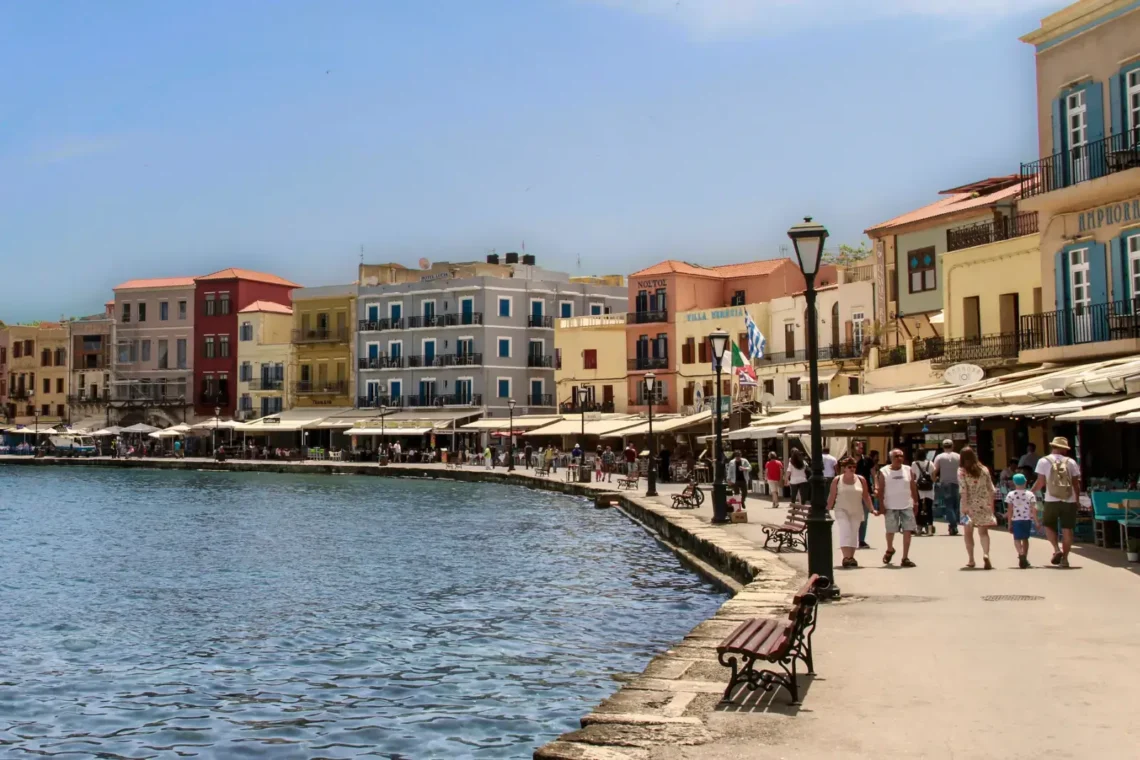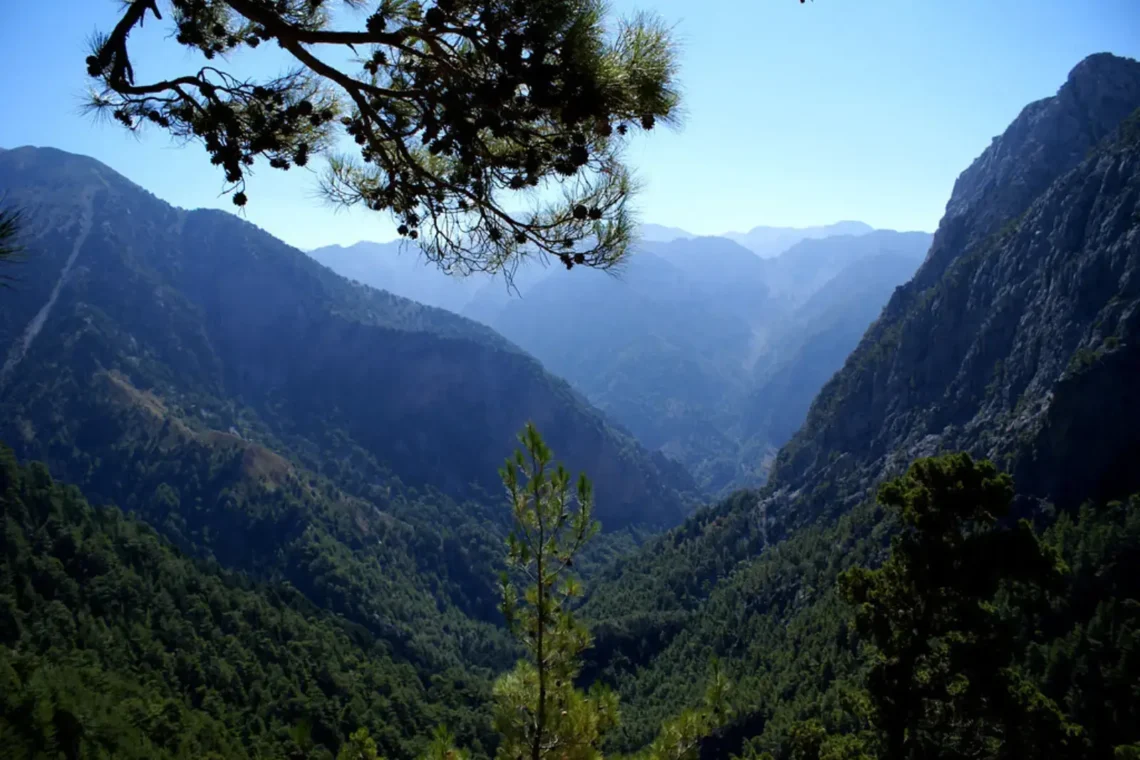Last updated on July 27th, 2024 at 02:35 pm
Western Crete is the largest region on the island of Crete. If you have only a week’s vacation, it’s best to concentrate on a single region, or risk spending a lot of time in transport. We suggest you visit Western Crete in one week.
We’ve created a detailed itinerary based on one week’s travel that you can use when planning your trip. You’ll find that Western Crete is the most diverse region as far as landscapes and people.
You can expect picturesque beaches, dramatic cliffs, lush valleys, astonishing rock formations, and verdant vineyards all within an hour or so drive from the sea.
Here is a suggested itinerary for exploring Western Crete:
- Day 1: A day in Chania.
- 2nd day: A pleasant day on the way to the Akrotiri monasteries.
- 3rd day: A day trip to Balos and the island of Gramvoussa.
- 4th day: Elafonissi is a beautiful beach resort on the western coast of Crete.
- 5th and 6th day: Two days to discover the beauty of the gorges.
- 7th day: Rethymnon is a small city in Crete full of surprises.
Practical information for visiting West Crete
West Crete is a part of the prefecture of Chania and covers the western part of the island. It is characterized by its mild climate, sandy beaches and mountainous landscape with olive groves. The western coast of Crete has long been regarded as one of the most beautiful regions in Greece.
Here are some practical information:
Weather
The weather in Crete is typically Mediterranean, with mild winters and hot summers. The average temperature in January is 8°C (46°F), but there can be snowfalls on the mountain peaks. In July, the average temperature is 25°C (77°F). However, it can get very hot during the day and quite cool at night.
Transport
West Crete is easily accessible by car, bus or boat. The most scenic route is by boat from the port of Chania to Agios Nikolaos. There are also daily ferries from Piraeus via Kythira island, and frequent buses from Athens and other cities in mainland Greece.
Tourism infrastructure
Tourism has traditionally been the main economic activity in West Crete, which has a variety of accommodation options and facilities for visitors. The region’s main tourist attraction is its beautiful beaches, which are among the best in Greece. There are also many archaeological sites such as Knossos and Phaistos, as well as medieval towns like Chania and Rethymno with their Venetian architecture.
Shopping
There are some excellent shopping opportunities in West Crete, particularly for jewelry, pottery and local produce such as olive oil. The island has several traditional markets where you can buy everything from fresh fruit and vegetables to clothes and souvenirs.
Health
West Crete is one of the sunniest parts of Greece, so make sure you pack plenty of sunscreen if you plan on spending time outdoors during your holiday. You should also take out insurance before traveling as medical treatment can be expensive in Greece if you don’t have cover.
Activities in Western Crete – Day 1: A day in Chania

Chania is a town in western Crete that offers many museums and historic buildings, as well as churches. The city also boasts a lively nightlife, which is why many people choose to stay here for a few days before continuing their journey around the island.
If you’re traveling with children, you’ll be glad to know that there are plenty of activities for them in this town. You could take them to the Archaeological Museum or the Municipal Art Gallery, which both house interesting collections of artifacts from ancient times. Children will also enjoy visiting the zoo on Kastelli Hill or seeing the famous Viglia (watchtower).
Chania’s old town has many places worth visiting, including Venetian mansions such as Palazzo Bonaparte and Palazzo Labarba Santoro; as well as other buildings like the Cathedral of Agios Prokopios or Byzantine churches like Agia Paraskevi.
Practical tips:
- We recommend staying in the picturesque old town center. There’s plenty of individual accommodation on offer, as well as some very nice little hotels.
2nd day: A pleasant day on the way to the Akrotiri monasteries

From Chania, we highly recommend a day trip to the monasteries on the Akrotiri peninsula, east of Chania. Just a short drive from the airport, you’ll discover several little wonders.
It’s well worth visiting four different monasteries on this trip: Timios Prodromos and Agios Nikolaos Prodromos, both nearby; Agia Triada and Panagia Halandriani.
Timios Prodromos is easily accessible from Chania by car or taxi and is open daily from 8 am-3 pm (entry fee). The other three monasteries can be visited only on Sundays from 10 am-1 pm (free entry).
If you start your journey at 8 am, you should have plenty of time to visit all four monasteries before heading back to Chania for lunch.
Agia Triada
Agia Triada (Sainte Trinité) is a monastery founded in the 17th century by two Venetian monks who converted to Orthodoxy. Set at the end of a cypress alley, amidst fields of olive trees, this orange-hued monastery is superb.
Inside, you’ll find a flower-filled courtyard, cats purring in the shade of lemon trees, a shady cloister, and a beautiful three-domed church… all of which add up to an atmosphere full of tranquility and solemnity. A small museum displays beautiful icons and manuscripts.
After a short drive through the olive groves, you’ll find yourself at the end of a winding road. This is Agios Governetou, one of the many monasteries that dot the island’s landscape. It was built in 1542 and is named after an icon of the Virgin Mary that was discovered here.
The monastery is still inhabited by monks today and can be reached by walking down a dirt path or driving down a narrow road. The beauty lies in its simplicity: just square walls, arched windows, and a small rectangular bell tower.
As soon as you arrive, you’ll hear bells ringing from inside the church. Inside, there are no other signs of life besides some baklava for sale at the entrance. The interior is simple yet elegant with beautiful proportions and columns supporting arches that divide each side into three sections: one central aisle flanked by two lateral ones.
The most impressive part of this monastery is its central dome painted with gold leaf depicting Christ Pantocrator surrounded by 12 apostles representing each month of the year according to their birth dates (January = Andrew, February = Peter, etc.)
Panagia Halandrian
The church is dedicated to the Virgin Mary and was built in 1742 by yeomen who lived in the area. The church was damaged during the Turkish occupation of Athens (1821-1830) and then again in 1833 when it was destroyed by a fire that also affected many other buildings in Halandri.
According to tradition, after a powerful earthquake destroyed much of the city and its suburbs in July 1955, a miraculous icon of Our Lady appeared on a rock near the church. When people went to see it they found that it had been carved into a small chapel with natural light coming through two holes where eyes would be located.
Practical tips:
- The peninsula is poorly served by public transport, so you’ll have to get there by car.
- Bring a picnic and water, as there are no restaurants on site.
- Access to the sea allows you to swim at the end of the peninsula, so don’t forget your beach gear.
- For the walk to Katolico monastery, allow enough time to climb back up from sea level.
3rd day: A day trip to Balos and the island of Gramvoussa

If you want to experience a unique landscape, we recommend this organized excursion from Chania: a day trip to Gramvoussa via Balos Bay. This day trip by boat will take you along the fine white sands of some of the most beautiful beaches of western Crete you’ve ever seen.
Located at the extreme northwest of Crete, the island of Imeri Gramvoussa had a privileged position from which to observe ships. For this reason, a fortress was erected by the Venetians in the 16th century. It can only be reached by sea, thanks to cruise ships departing from Kastelli Kissamos.
A little further south, and accessible by both land and sea, is the extraordinary Balos lagoon. It lies at the foot of the island of Tigani. Its blue-graded waters and white sand are well worth a visit. The beach is located at the end of an 8km track, and you have to walk a further 2km to find the beach.
Practical tips
- There are no restaurants on the island of Gramvoussa, or Balos beach.
- Plan either a picnic or a stopover at Kastelli Kissamos, where there is a pleasant beach and a good restaurant.
4th day: Elafonissi is a beautiful beach resort on the western coast of Crete.

Elafonissi is a small resort in the south of Crete, close to Matala and Agia Galini. It has a long stretch of white sand beach, but it’s quite popular with tourists.
If you’re coming from the north, we highly recommend taking the road overlooking the Topolia Gorge. Don’t hesitate to admire them by stopping off at the Agia Sofia cave. Not only does it offer a splendid panorama, but it’s freely accessible and children love to play explorer.
The beach at Elafonissi is impressive. Again, white sand (almost pink, in the light of the setting sun) and crystal-clear sea. Opposite, a small island can be reached on foot across the sand. The beach, however, is very popular with tourists and beach umbrellas in summer. It can also be extremely windy.
A little further away, and less touristy, is the small wild beach of Kedrodassos.
Practical tips:
- Elafonissi has a restaurant on site, but there is little shade and it is very hot.
- If you want to enjoy the sea, it’s best to do so at the end of the day.
- To make a loop, you can return via the West Coast road, which is superb at sunset.
5th and 6th day: Two days to discover the beauty of the gorges

The Samaria Gorge is a natural wonder that has to be seen to be believed. It’s one of the most impressive gorges in Europe and one of the best places to hike in Crete.
The Samaria Gorge is located near Chania, on the west coast of Crete. The gorge reaches a depth of 1,000 meters (3,280 feet) over its length of 16 kilometers (10 miles). It’s not easily accessible though: there are no roads leading directly to it.
The best way to visit is by booking an organized tour or taking a taxi. You can also go independently but this requires you to take a bus or car from Chania first and then walk for about 2 hours before reaching the gorge.
This article will give you an overview of the different ways you can visit the Samaria Gorge so that you can decide which suits your interests best!
You can spend two days hiking in Crete’s gorges. We did the Samaria Gorge, which is not accessible from Hora Sfakion. You need to get a car and drive to the other side of the island.
But there are other gorges in Crete too. We went to the Aradena Gorge. They’re more accessible and simpler. The Imbros Gorge also offers a 2.5-hour hike, with some spectacular passages. For the latter two, it may be worth staying at Hora Sfakion. We loved Loutro, a good starting point for hikes to the Anapoli plateau.
Practical tips:
- Before venturing into a gorge, make sure you have all the information you need about its characteristics and accessibility. In some cases, it is possible to enter by boat (Samaria, Aradena).
7th day: Rethymnon is a small city in Crete full of surprises

On arrival in Rethymnon, you can stroll along the promenade, which runs along the sea. A little further away from the town center, you’ll find a small harbor and a beach. The old town is a fine example of a cultural melting pot. It retains the charm of a Venetian town, with its ochre tones, harbor, and middle-class houses. But the Turks also left their mark: mosques and wooden balconies.
Don’t miss a visit to the fortress, which overlooks Rethymnon’s old town. You’ll discover a maze of narrow streets that wind up towards the fortress walls. From here you’ll be able to admire wonderful views over the old town rooftops and enjoy an ice cream at one of the many cafes in situ!
Practical tips:
- Travelers can leave their cars in the outdoor parking lots and take bikes around town.
- And those who book hotels in Rethymnon’s old town will enjoy an evening walk through its lovely streets.
Western Crete presents a rich cultural heritage and marvelous natural beauty. In a week-long trip, you will discover some of the most beautiful corners of the region while immersing yourself in its history and traditions. More importantly, you will experience a way of life that is rooted in community and tradition.
More About Greece
Greece’s Most Beautiful Beaches in 2023
The beaches of Greece are a paradise for beach lovers. So, we’ve put together a list of our favorite Greek beaches to help you make the most of your time in this beautiful country.
How Has the Greek Language Influenced The World
Greek is often regarded as one of the foundational languages of Western civilization, but it is not considered the “mother” of all Western languages.
Ancient Goddesses: Powerful Women in Greek Mythology
The presence of Goddesses and powerful women in Greek mythology is vast; in fact, it is not inferior to that of men, and in many instances, it surpasses it.
The Best of Western Crete in One Week
This road trip itinerary is designed for people who want to explore the best of Western Crete in just one week.
The Olympic Games in Ancient Greece
The Olympic Games in ancient Greece were a major sporting and cultural event that took place every four years in Olympia, a sanctuary dedicated to the god Zeus.
Revealing Most Important Figures of Greek Mythology
Greek mythology is a rich tapestry of divine beings and stories, with each generation of gods possessing its own unique qualities, roles, and rulers.












Comments